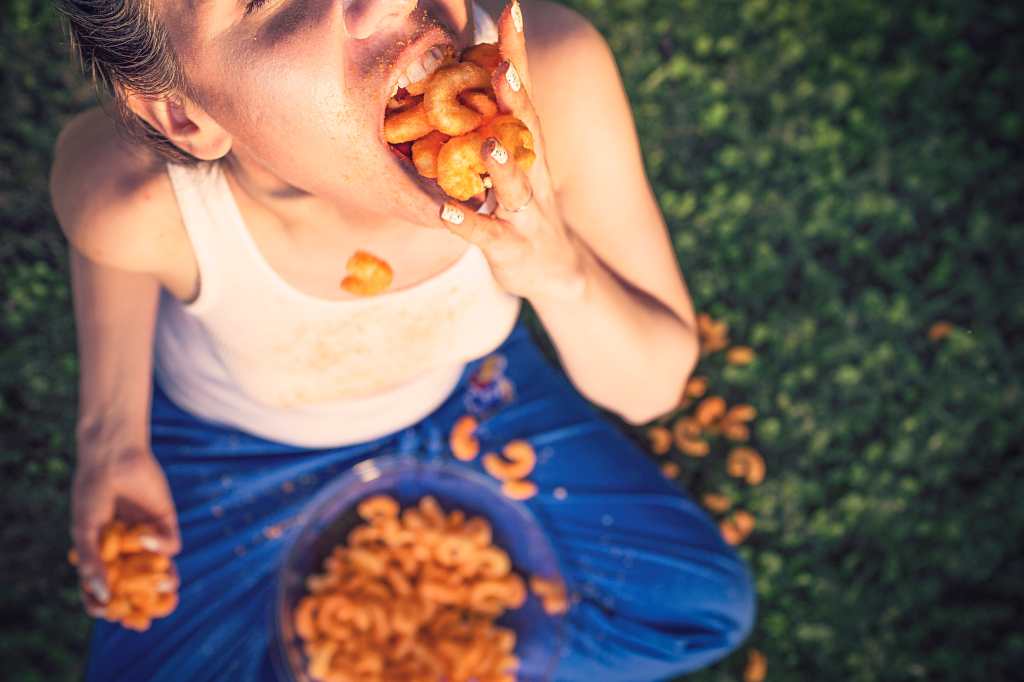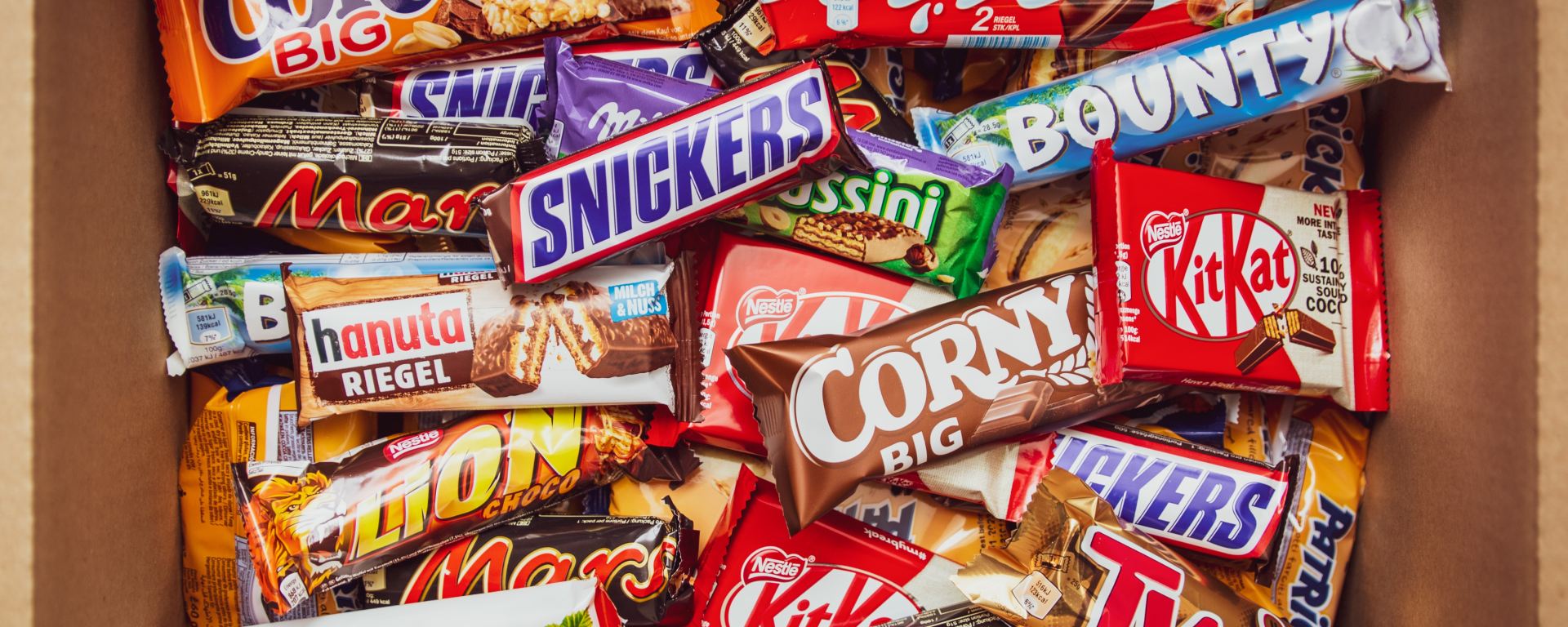There’s a difference between enjoying a daily treat and mindlessly eating your fifth cookie of the morning. You may wonder how to stop snacking for good – and that’s exactly what I’ll show you in this article.
We all know that compulsive snacking can grow into a BIG issue.
Especially when you are trying to maintain a healthy weight, reduce sugar or improve your general health.
So I am going to offer you my favourite technique. One that is guaranteed to help you stop snacking for good, providing you actually follow the simple rules.
Again, if you commit to doing it, you will see positive changes in your life.
(🎙️ Prefer to listen to this article? You can do exactly that by checking out podcast episode #28!)
What is compulsive snacking?

Before we get into how to stop snacking, let’s look at what compulsive snacking actually is.
Compulsive snacking or mindless eating is when you snack throughout the day. You constantly eat too much for reasons other than physiological hunger.
It may also be known as emotional eating, because snacking is often done as a source of comfort to combat negative emotions.
However you prefer to describe it, compulsive snacking comes in many forms.
And sadly, it can be the biggest roadblock to your fitness goals and health in general.
Interestingly, research on snacking (2020 Food & Health Survey) reported that snacking increased among people under the age of 35, as well as parents with children under 18 years, during the Covid-19 pandemic.
As a parent myself, I can sympathise with the latter! However, in my experience, compulsive snacking is a universal problem, shared by people of all ages.
Why is compulsive snacking a problem?
Let’s face it, if you are reading this and have an issue with snacking, it’s probably not because you love to snack on fresh fruit.
Or spinach leaves. Or lean protein.
It’s probably because you have an insatiable lust for calorie-dense foods.
Things like doughnuts, ice cream, sweets, cookies, cakes, crisps, pretzels, bread, random lumps of cheese, and other calorie dense foods.
There is nothing wrong with enjoying these foods from time to time.

(Yes, even if you are trying to lose fat or maintain a healthy weight.)
I enjoy crisps, chocolate, cake and pretty much everything else I just mentioned.
Obviously, the problem is what happens when you are just grazing on them through the day.
You can put away 500 to 1,000 calories or more by just mindlessly shoving things into your mouth.
Having worked with many compulsive snackers, the saddest thing about this is that most of them don’t even want the snack.
Or they don’t really enjoy it. Or they haven’t been paying attention and just polished off a bag of cookies without really tasting them.
This is when snacking can become a problem. When you lose control over what you are putting in your mouth.
When I say lose control, I don’t mean going ‘BLEAGHH’ and throwing things into your mouth.
I mean it’s when you are eating snacks to satisfy urges such as stress, boredom, anger or other emotions aside from pleasure or hunger.
For example:
- You’re feeling stressed at work so you shove three cookies into your mouth
- You’re depressed, so you pig out on ice cream
- You’re bored, so you eat that entire chocolate Easter egg while watching TV
It’s understandable. For many people, eating can help ease uncomfortable emotions, whether that’s consciously or unconsciously.
But when you are eating too many calorific snacks on top of your meals, it is less conducive to maintaining a healthy weight.
You probably didn’t need me to tell you that!
There are lots of things you can do to stop snacking or reduce snacking. In fact, in another article on Planet Health, I discussed using chopsticks to reduce snacking.
However, there is one technique that I always recommend.
This is something that has worked wonders with people I have coached. I guarantee that if you put it into action, it will help you control snacking for good.
How to stop snacking: the technique

As I have mentioned, this technique works best for mindless snacking.
Remember that everyone (yep, even you) is allowed to treat themselves. So if you have planned a little treat, there’s no need to use this technique.
What is the technique to stop snacking?
It’s simple and it goes like this:
- As soon as you have the urge to eat something that doesn’t support your healthy living goals (say, some good ol’ fashioned chocolate chip cookies), set a timer for five minutes.
- As soon as the five minutes are up, you can enjoy those cookies.
That’s it.
🙄
Okay, you got me… there are two more rules:
You MUST use a timer to track five minutes (your smartphone, watch or kitchen timer will do).
You MUST commit to sitting with the urge to snack for the full five minutes.
Here’s why it works
Allow me to explain how this technique works.
Basically, what we are doing is giving you full permission to jump in and eat those cookies, but only AFTER the full five minutes is up.
This works because you are not denying yourself.
You are simply sitting with the urge for five minutes.
If you have never done this before, it may be very uncomfortable. You are probably used to just opening the cupboard, ripping open the bag, and shoving the snack into your mouth.
But persist.
It’s during these five minutes of discomfort where things get interesting.
This is where your urge to snack can vanish.
Now, during these five minutes I want you to consider a few things.
First, ask yourself WHY you want to eat the snack.
- Is it because you are hungry?
- Are you craving something sweet?
- Are you a bit bored?
- Are your kids stressing you out?
- Are you going through a breakup and feeling depressed?
- Is your family having cookies and you think you should too?
- Is it because the cupboard is looking messy and getting rid of those cookies will definitely help make the cupboard look tidy again?
There are tons of reasons why you may want those cookies – and five minutes is plenty of time to figure it out.
However, it’s also enough time to consider alternatives to snacking.
For example:
- If you are hungry. Is there a better choice that will fill you until your next meal? Perhaps a protein snack or fiber snack – carrot sticks and hummus? Or a yoghurt and fruit?
- If you are craving something sweet. Could you try a healthier alternative to cookies? Perhaps some fruit or a lower-calorie snack, such as lightly-sweetened popcorn?
- If you are bored. Is there a better way to pass the time thank snacking? Could you read a book? Go for a walk? Do some chores? Play a video game?
- If you are stressed. What’s bothering you? Can you try some breathing exercises? Talk to a friend, go for a walk, or just punch a pillow?
You get the idea.

These thoughts probably won’t take long.
You’ll quickly be able to figure out whether you are hungry, sad, bored, stressed, or so on. You can also quickly figure out an alternative.
So I suggest using the rest of the five minutes to consider your goals and motivation.
For example, if you are trying to maintain a healthy weight or lose some fat, think about WHY you are trying to do this.
It can be as superficial or as profound as you like.
Maybe you want to fit into a new dress or t-shirt? Maybe you have kids, and you want to set a good example. Or maybe you just want to live a healthier life and being at a lighter weight will let you to do this.
It’s YOUR goal.
But reminding yourself of your goals and motivation gives you a reason to say no to the snack. It’s a reason to go and do something else.
Suddenly, DING! The five minutes is up.

What happens now?
The question now is: Do you still want the cookies?
If the answer is yes, then that’s fine.
You have made an informed decision.
You met your end of the deal. Go and enjoy some cookies!
Remember, this deal is not about denying yourself treats or snacks. It’s about understanding why we eat. Then making decisions that are conducive to our goals and motivations.
Now this technique isn’t going to stop you snacking every time. Sometimes you will want that treat – and that’s fine.
But it is a powerful technique that will help you make better choices, providing you sit with the discomfort.
Of course, you don’t have to just sit there; you can also go distract yourself with work, or exercise, or video games, or chatting to a friend.
The timer is still there in the background. When it ends, you will probably have forgotten all about it.
The final word on how to stop snacking
Snacks are one of life’s little pleasures, but when they begin to get out of control, they lose their enjoyment.
As I have mentioned, this technique really does work to help you stop snacking. But only when you commit to the rules of the deal.
Honestly, even if it helps you reduce your snacking by HALF, you may be shaving hundreds – or maybe thousands – of calories from your weekly eating.
That’s a small step that can make a HUGE difference when you are trying to maintain a healthy weight.
Thanks for reading! 🙂 If you enjoyed this article, then please share it with someone else who may need help with snacking.

